Apparently, rapper 50 Cent is a Municipal Waste fan. From the great info-dump that is Facebook:

Tags: municipal waste, Thrash
Apparently, rapper 50 Cent is a Municipal Waste fan. From the great info-dump that is Facebook:

Tags: municipal waste, Thrash
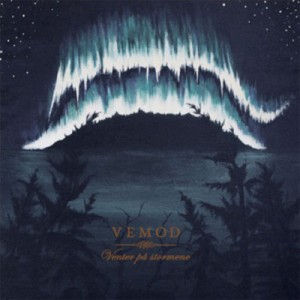 Nostalgia is like going back to your rapist and asking for your first kiss. If I were a 2000s kid, I’d want to be part of those glorious days of the early 1990s. As a 1990s kid, I might want to “go back.”
Nostalgia is like going back to your rapist and asking for your first kiss. If I were a 2000s kid, I’d want to be part of those glorious days of the early 1990s. As a 1990s kid, I might want to “go back.”
Yet you can’t go home again. All you can do is re-heat and imitate the past, and hope that the magic comes back. But the magic came from the convergence of the time, what was going on in the world, and the art. That isn’t to say the music isn’t still relevant; it is eternally relevant. But what made it great was how it was organized in the minds of its creators, not the techniques they use. Trying to imitate the techniques is thinking backward, or going from the whole impression to try to recreate the idea it conveys, instead of finding that idea and using it to make another (not necessarily new, but more accurate) impression. I could buy ten truckloads of these retro-imitative albums and I’d still be in nowheresland, ready to trade my left testicle for the ability to buy Transilvanian Hunger or Pure Holocaust again and to experience the joy of discovering it again, like the very first time!
But it is not to be. We wouldn’t want it to be that way. Time marches us forward both toward doom and toward greater heights. Vemod adopts a mix between the Ulver-styled late Nordic material and the French-style barely-holding-on black metal of the wave after the Nordic black metal explosion. That being said, there’s nothing to criticize Vemod for. They play perfectly, many of these riffs are catchy, and they use extended interludes well. There’s just something missing at the center, sort of like there has been in modern life, where we wonder what the point of it all is. As it is, these songs leave us with a feeling of melancholy, having missed the bus to the land of adventure, and maybe a bit of dark loneliness. But after that, it is just decoration.
9 CommentsTags: Black Metal, vemod
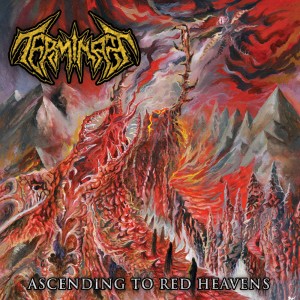 Any band making music of a vaguely “Swedish style” is going to attract both absurdly high hopes and cynicism, and Terminate fulfills some expectations from each column.
Any band making music of a vaguely “Swedish style” is going to attract both absurdly high hopes and cynicism, and Terminate fulfills some expectations from each column.
Mixed emotions about Swedish-style death metal appear mainly because the recent “revival” of Swedish death metal is more like an “imitation” of the past using the bad techniques of the now. A lot of bands picked up Boss HM-2 pedals, dimed their amps and switched to flying Vs, then mixed a few classic Carnage, Nihilist and At the Gates riffs into their bog-standard death metal with the design philosophy of a cardboard box.
Terminate may or may not fall into this category, but their rendition of Swedish death metal is more like what happens now than what happened then. Its verse-chorus approach is sparse with riffs and heavy on repetition, and its songwriting is blocky, in that these riffs don’t particularly appear to relate to each other and the need to drop in a note-shifted favorite from Left Hand Path or Like an Ever-Flowing Stream cramps their songwriting. The other struggle this band faces is that their choice of notes, chords and rhythms is what we might call “obvious,” meaning that these will always be common variations of the most basic approach to writing this style of music, and they’re not particularly evocative ones.
As any reader with an IQ over his or her shoe size can guess, the overall style here is “Swedish death metal,” which is now as much TM as the Nordish foods at the front of Ikea. Terminate use the crunchy riffs that gradually create a melodic mood, although here it’s more like a side-step from crunch to melody, and build an architectural sense of the sonic space in which death metal moves. Vocals are equally gruff and guttural, sounding a lot like Carnage or Utumno on a bad day.
Ascending to Red Heavens distinguishes itself because it is not cynical toward its subject matter. The band dives right in and goes for the death metal thrills of thunderous riffs and dark passages culminating in near-nuclear levels of antagonism. Whether this rises above the average is an exercise for the reader, but at least this band, like other Swede-worshippers Disma and Decrepitaph, enjoys its subject matter and tries to be faithful to the idea of it as a whole.
7 CommentsTags: death metal, Swedish Death Metal, terminate
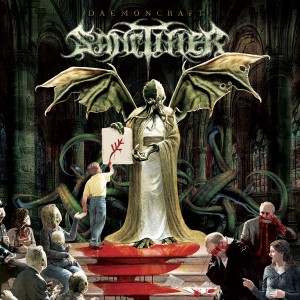 Sanctifier craft fine quality vintage-sounding Brazilian death metal, straight forward and without the desire to pander to the elitist shit contingent wanting the next trend. These death metal maniacs have been kicking around since they were teenagers in the 80s and are not children of the tape-trading phenomenon but instigators of it.
Sanctifier craft fine quality vintage-sounding Brazilian death metal, straight forward and without the desire to pander to the elitist shit contingent wanting the next trend. These death metal maniacs have been kicking around since they were teenagers in the 80s and are not children of the tape-trading phenomenon but instigators of it.
For that reason, while Daemoncraft displays its Brazilian sound right off the bat with a warped rhythm weaving through opening track “Demon Ov Lava” (which is also added as a bonus track with Portuguese vocals at the end of this CD) they’re also influenced by their peers of the time such as Immolation and latter-era Morbid Angel (i.e. during Rutan’s relocation from Redbank to Tampa). To my ears at least, this mid-period death metal influence shows up musically on this recording and appears more prevalent than other pioneering influences the band naturally does have.
Getting robbed at gunpoint and thus losing his equipment didn’t hold sole song writer Alexandre Emerson back from creating some wicked songs yet again in the name of worshiping the ancient ones, even before it was a fashion with the young whipper snappers after this sort of music became available at the mall. The cult of Cthulhu remains central to the driving force behind the writing of this music. Lyrical content avoids any crypto-punk subject matter which was par for the course when this band were teenagers and is consistently so now that they’re seasoned elders of the genre.
Daemoncraft emerges as a compact album with some amazing guitar work that has just the right amount of more modern (i.e. early 90s style) feel meshed with the primitive proto-death metal of the 80s from which this band is forged. “The Enchanter” is a good example of this layering of feeling between the two realms. However, the song is consistently deliberate throughout and makes for an excellently paced album.
I agree with executive producer Everton De Castro of Dying Music when he says Daemoncraft is a work for metal brothers of the death metal old school; for those who aren’t just here for a trend, is there any other kind?
Tags: death metal, sanctifier
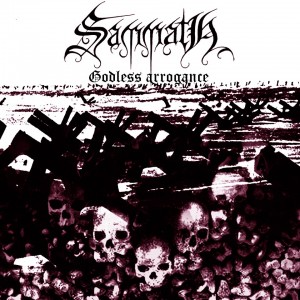 Dutch-German blazing black metal act Sammath, who are preparing to unleash their fifth album, Godless Arrogance, have signed to worldwide metal music label Hammerheart Records for the release of that album.
Dutch-German blazing black metal act Sammath, who are preparing to unleash their fifth album, Godless Arrogance, have signed to worldwide metal music label Hammerheart Records for the release of that album.
“I’m getting emails and telephone calls from people all over the world,” said Sammath guitarist/composer Jan Kruitwagen on the change that catapults them from a smaller metal label to worldwide distribution on par with Relapse and Nuclear Blast. The band is leaving its label of sixteen years, Folter Records, on amicable terms. “Joerg from Folter was actualy proud as fuck that we got signed to these guys and only wishes us well. It wasn’t easy telling him after 16 years on his label, but he understands.”
According to Kruitwagen, Hammerheart sought Sammath after hearing the demo tracks from the upcoming album and knowing the band for a long time. “The new tracks will destroy! Guido from Hammerheart knows what’s good,” he said. Believed by many to be the boldest step of the band’s career, Godless Arrogance combines the elegant melodies of Sammath‘s first album, Strijd, with the aggressive ripping death metal approach of their most popular work, Dodengang.
The band doesn’t plan to change a thing about their approach, which is old school technique and composition with an eye toward defiant independence. “We have lots of work left to do. All drums are recorded without triggers and everything is recorded live. Getting this all sounding like we want takes time. We do everything ourselves, no hands but ours will finnish this CD, except Peter Neuber for the master (Necrophobic, Revenge, Severe Torture),” Kruitwagen added.
Godless Arrogance will see release in “a couple of months at least,” but will not change its approach. “We need to make sure it all sounds up to mark, without losing the intense sound it already has,” said Kruitwagen. He added that despite a changing music industry, the band remains committed to its approach. He added, “let the music speak for itself.”
The tracklist for Sammath‘s Godless Arrogance will be:
1. Shot in mass
2. Fear upon them
3. Thrive in arrogance
4. Death (hunt them down)
5. This world must burn (hammer of supremacy)
6. Through filth and the remains of man
7. Nineteen corpses hang in the mist
Tags: Black Metal, sammath
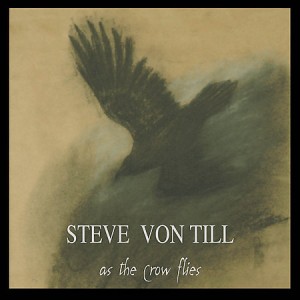 It is one thing to become acknowledged within your genre as a leader. It is still another to reach outside that genre, and become more than an artist, but a sage.
It is one thing to become acknowledged within your genre as a leader. It is still another to reach outside that genre, and become more than an artist, but a sage.
A sage is part explainer of the past, part philosopher and part artist who makes the future seem full of interest and beauty. No matter how long someone labors in popular music, they will eventually desire to become the village sage, because that is a position above entertainer. It is a trusted voice that is a guide for culture.
Steve von Till rose to fame with Neurosis, whose music he took far beyond hardcore into the realm of psychedelic and experimental music. With this re-issue of his solo album from 2000, we can hear his voice develop from rage and ambiguity to a desire to reform culture itself. This acoustic guitar album shapes itself from simple melodies and muttered, droning vocals melded into slow atmospheric songs.
As The Crow Flies attempts to create a folk music out of the postmodern time, having let the ashes of dystopia fall. These songs are sentimental and emotional, but not in the cloyingly insistent way that pop must be. Instead, like the music of Tom Waits or Dead Can Dance, songs try to nail the feeling of a particular time in life and galvanize us toward both clarity and an amorphous desire to surpass the past.
von Till carefully paces the album so that songs appear in a varied order, using additional instruments sparsely to differentiate themselves, such that mood is not broken but slowly changes like a banner twisting in a nearly-becalmed afternoon wind. These are songs both unexpected and familiar which wring out of our decaying age a new reason to believe in the emotional power of living, and that makes As The Crow Files a success of a different color.
1 CommentTags: folk, neofolk, neurosis, steve von till
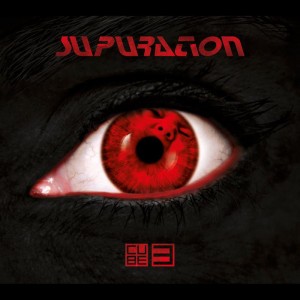 During the early 1990s, death metal was subject to criticism because people feared it. They would claim that the bands couldn’t play, or didn’t know their scales, or were otherwise incompetent.
During the early 1990s, death metal was subject to criticism because people feared it. They would claim that the bands couldn’t play, or didn’t know their scales, or were otherwise incompetent.
One of the first bands to thwart this vision was France’s Supuration, a former grindcore/death metal band who gradually modified their style as they grew more proficient with their instruments. The result was a mixture of rock, pop, death metal and progressive music.
The Cube, Supuration‘s most famous work, introduced sci-fi concept album planning into the fertile mix of metal and progressive rock. Over the last 20 years, the fame of this legendary album has only increased as more people discover it and are able to understand it, now that an intervening two decades of progressive metal have made it easier.
This year, Supuration launched Cube 3, their follow-up to the original album and a means of uniting the storyline of intervening albums. We were fortunate to get to talk to Ludovic Loez, guitarist with this groundbreaking band.
You started out as a death metal or grindcore band, and then made the change to a progressive/rock/metal style; what spurred this change? Did your interests change, or did the newer style fit your interests?
After the recording of The Cube album and Still in the Sphere MCD, we decided to change our style. We didn’t want to record another The Cube in the same vein; we tried to create a more experimental music, with no limits for us. We like SUPURATION a lot but we thought that a second album in the same veins would not be cool for us, that’s why we created S.U.P.
How important do you think style is in the creation of music? Can someone make the same album in any style, or does the style fit the music? How does this relate to individual songs — does song structure need to fit the song, or is there a way to say the meaning of any song in any song structure?
I think the structure is quite important for a song; we are trying to be original, we all love death metal style in the band, but we also like new wave music and VOIVOD for example. If you listen to our three SUPURATION albums, you’ll find the same structures: each album is linked to each other; for the S.U.P albums, each album is a story, but the structures of these albums are different even if it’s the same way of writing songs for both bands.
You’ve obviously spent a lot of time listening to metal and studying its riff forms, but there’s other elements in there in addition to your own “home grown” outlook and style. You’re probably tired of people asking this, but what are your influences??
As I told you we are into new wave of the 80’s, real gothic music like THE SISTERS OF MERCY, VOIVOD, old PESTILENCE, DEPECHE MODE and sometimes electro music coming from Germany. We are also into original soundtrack, music scores…
Do you think the death metal style easily transitions to progressive rock? What do you see as the similarities between the two? Is progressive rock — most people don’t know that Tony Iommi was briefly in Jethro Tull, or that King Crimson’s first album was an influence on Sabbath — a part of metal, encoded into its DNA?
I think you’re right, in each style of music you can hear a “small” part of metal especially nowadays with the evolution of music in general…The way to the progressive rock is natural I think, except for brutal death bands like SUFFOCATION or CANNIBAL CORPSE and so on, it’s certain that they won’t turn into progressive [music]. It’s a choice, everyone have the choice especially in music.
A compilation of your early works, Back From the Crematory, was released in 2011 and seemed to spur some interest in the early years of the band. What first attracted you to grindcore and death metal?
CARCASS, NAPALM DEATH, OLD. We were quite young at that time and we were into grind core and death metal, when xtreemmusic asked us to put out our first work with ETSICROXE and early SUPURATION, we were really excited. Imagine your old demos and rotten live on a cd more than 20 years after…amazing and exciting…
You split the band into two entities, “Supuration” which was more metal, and “S.U.P.” which was more future pop/rock/progressive. Why did you make the split? Were you able to keep the two separate? How much did they converge, or become similar?
They’re sometimes similar, the voice for example. We created another the band because after the “success” we had with The Cube, we didn’t want to record a “Cube II” the year after. We wanted to create something new with music. The two bands are two different entities, but same members and same songwriter, so both are sometimes similar and different at the same time.
Have you seen interest in Supuration renewing itself recently? Why do you think this is?
I think it’s great!! With the new record company it’s quite easier. We had had a small renewal with the prequel of The Cube called Incubation in 2003. We have good reviews — I think the result is quite correct, that’s a good thing for us…
I have known relatively few albums that attract the kind of devotion that The Cube has. What do you think makes that album stand out, and what do you like about it most?
Its story, its concept, its futurist cover; this album realized in 1993 had a big success in general I can’t explain why…but it’s cool….
You’ve just released Cube 3, which alludes to the original The Cube. Do you think it’s a continuation of what was done on The Cube, a re-envisioning, or an entirely new direction using parts of the same storyline?
Cube3 is dealing with the end of the story [from] The Cube. Between these albums we recorded Incubation which is a prequel to The Cube, I mean the story before. If you want to hear the whole story you have to listen to Incubation first the reasons of the suicide of the young girl, then The Cube with the journey of the tormented soul throughout strange places and Cube3 which deals with the reincarnation of the soul of The Cube album.
Most of your albums seem to be conceptual, or united around a story or idea. Can you tell us about the storylines in your albums? Was there a consistent story idea through all of your works?
I would say, in most of our stories in our albums, the relation between the mother and is child is reccurent. You’ve got this relation in the whole story of The Cube, in “Anomaly” (S.U.P, science fiction dealing futurist machines that kills babies linked to a overpopulation in the future), “Room Seven” (S.U.P, story dealing with an autistic child and his mother), “Chronophobia” (S.U.P, twins separated at birth, mother killed in a carcrash), “Angelus” (S.U.P, quite different, dealing with the lost of faith in god and extraterrestrial life after death), “Imago” (S.U.P, also different, dealing with a futurist drug that makes a self regeneration after a serious disease or cancer, but quite dangerous if you take it twice) and “Hegemony” (S.U.P, dealing with a neovocyt, a new vegetal/human being who is trying to run away with the head of his mother throughout a searing desert somewhere in time on another planet).
Nothing sounds like Supuration — nothing! However, if I had to pick the closest, I’d point toward the first albums from Obliveon and Dead Brain Cells (DBC), and maybe mention some of the middle period Voivod material (Dimension Hatross). Do you find these bands similar? Is it odd, or perfectly rational, that they would have a similar sound to you? Does the fact that all of you are from French-speaking areas have anything to do with it?
I only know VOIVOD, I do not know DBC or OBLIVEON, I’m sorry. I don’t think we are similar, maybe we have the same way of seeing things, the same way of creating the music. You must be right — I trust you when you say that but…I don’t know if the French-speaking have anything to do with it…maybe….I don’t know maybe a similar culture somewhere…
Do you think metal’s riff style, which uses moveable chords like power chords and as a result ends up with longer phrases more like classical melodies or complex riff from prog rock, determines how you compose metal songs? Do you think this makes metal more or less like regular rock? Was it hard for you to integrate the two styles in your music?
You know, when you are used to playing in a way, it seems to be normal for you to play that way. I mean during these years metal music has changed a lot, except for some great metal bands that are staying in their metal style since the very beginning and that’s great too… There’s so many different styles in metal music, it’s quite difficult to answer this question, as far as we are concerned, we are writing songs normally, we’re trying to be original and not to disappoint our fans who are very important for us.
Some of your “S.U.P.” material, especially Room Seven, seemed to converge on a progressive alternative rock style that others were trying to achieve at the time. The use of non-standard chords, dissonance and off-time constructions in alternative rock appeared for example on Dweezil Zappa’s “Shampoo Horn” and even made it into punk with powerviolence and post-hardcore. What do you think influenced bands to move progressive in the late 1990s? What were they seeking to express, or change in the world? Did you see this as a confirmation of your direction (if you were aware of it)?
We’re not aware of it, sorry….I guess they tried to change some things in the world of music, I suppose…Every decade a new style is created in metal or death metal, it’s a kind of circle you know. We’re not into this kind of philosophy; we are trying to do our best for people who like our stuff and for our fans. I only know Dweezil Zappa because I was told that he was a very good guitarist, that’s it….
What’s coming up next for Supuration? Will you tour and/or continue releasing music? “Cube 3” seems a bit of a progression from your older material; what’s your next metamorphosis?
We’ll play some shows for Cube3, not real tour, I mean festivals, concerts, during one or two years and meanwhile I’ll star to write the new S.U.P album, we’ll see…. Thanks for the interview
Ludovic LOEZ
for SUPURATION/S.U.P
April 2013
Tags: interview, supuration
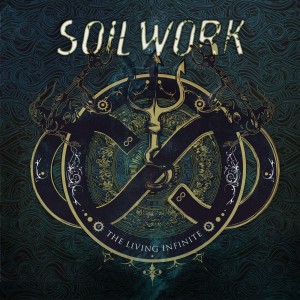 If you ever find yourself wondering why mainstream music produces so many professional and well-produced acts while metal seems pasted-together in comparison, worry no more: Soilwork has invented a new form of radio-friendly metal that competes with the big bands you can hear on the radio.
If you ever find yourself wondering why mainstream music produces so many professional and well-produced acts while metal seems pasted-together in comparison, worry no more: Soilwork has invented a new form of radio-friendly metal that competes with the big bands you can hear on the radio.
(more…)
Tags: alternative metal, indie metal, metalcore, power metal, soilwork
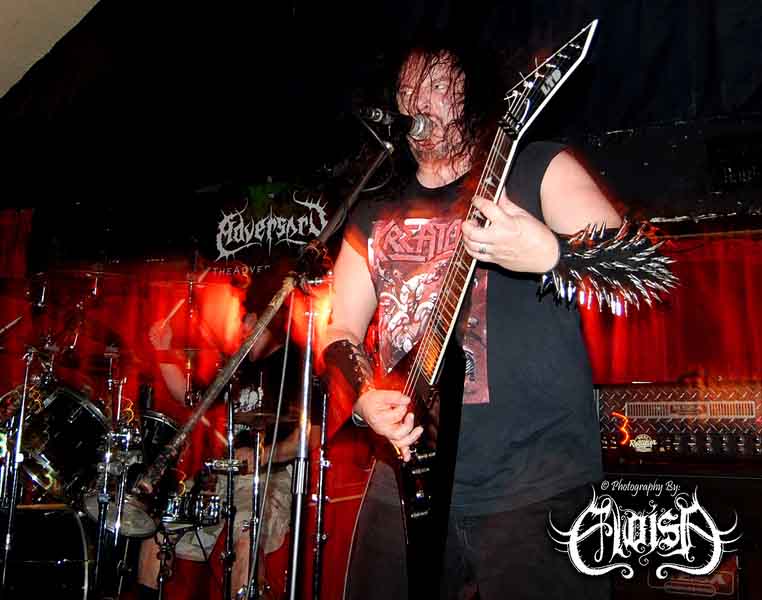 Tom Stevens has been providing technical extreme metal since the 80s. Known as a virtuoso on guitar and owning the distro/label Nokturnel Eclipse, he’s been a supporter of the old school since it began. Though Nokturnel has gone through numerous line-up changes, Stevens has defied odds and kept the flame burning with an indomitable urge to shred.
Tom Stevens has been providing technical extreme metal since the 80s. Known as a virtuoso on guitar and owning the distro/label Nokturnel Eclipse, he’s been a supporter of the old school since it began. Though Nokturnel has gone through numerous line-up changes, Stevens has defied odds and kept the flame burning with an indomitable urge to shred.
Nokturnel is what I would deem “old school technical blackened thrashy death metal” (OSTBTDM).
DeathMetal.org is proud to present an interview with Tom Stevens about his music and businesses.
Howdy Tom. Thank you for your time. What was the mentality that drove you to form Nokturnel? Was there a frustration that you had to unleash? Why did you spell “Nocturnal” as “Nokturnel”?
Nokturnel was not something I really intended to do, my first band Savage Death fell apart and black metal was “out”…. the Satanic thing took a dive and believe it or not it was considered uncool. I had only begun to take Savage Death into what was considered technical metal at the time, and when it fell apart I wanted to take technical to a new level. The drummer of Savage Death was cool with that and he went on to meet Martin O’Connor. By then I was beyond frustrated with generic sounds, so the three of us made Nokturnel as different as we could; we chose to spell it that way because we knew many other bands would appear with the same name.
What are your thoughts on religion? You have previously stated that you believe in aliens. Do you believe that aliens created the human species? How about a mutual collaboration of humans and aliens to further each other? Have you ever seen any UFOs?
Religion is too complicated for things that must be valued with “faith.” It never struck me. The song Force Fed Fear is about the fear knowing you were told there’s a price to pay for not believing in religion. I do believe in Aliens and think they have been part of Earth’s history forever…. I could accept the facts if they were proven; easy for me to have faith in believing in the existence of life other than here on this planet yet I cannot have faith in religion…. I think there will be good and evil Aliens… some will wanna help, some will want us for our worst nightmares… I have no trust in government and think it is a long established fact Aliens have already played their role in where we are now and we were are heading…
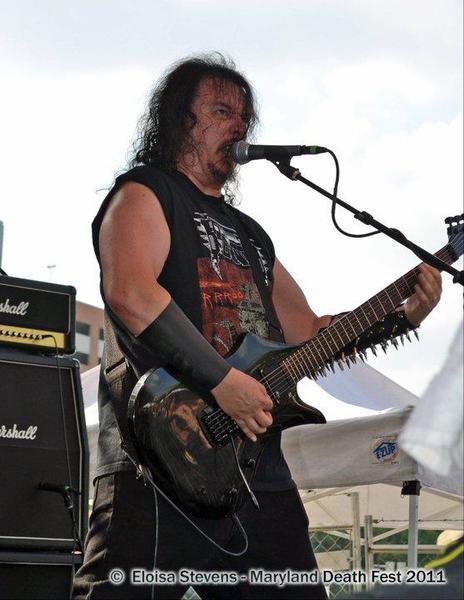 I haven’t heard much on Nokturnel since your last recording ‘Ancestral Calling’. What have you been up to?
I haven’t heard much on Nokturnel since your last recording ‘Ancestral Calling’. What have you been up to?
I managed to get that single recorded right before we played MDF. I had a lot of fan support at the time. It was amazing and heartfelt to be in the position I was in as an independent with no label support and I took it all very seriously. I had a lot of problems I would rather not get into but my stress level was at an all time high. I made changes as best as I could for Nokturnel. It was beyond maddening to be on the verge of taking things ot the next level and not have a stable lineup. I did two more shows which were clusterfucks for me…. the last one killed my drive to be on stage again until I have whoever is playing for me sounding exactly as I intended it to sound. With that mindset I chose to go into the studio alone for the third time to record “Shadows Alive,” I used Kevin Talley this time and it is my favorite Nokturnel song. It was redemption for my self…but unfortunately it did not get half the coverage “Ancestral Calling” received.
I am so fucking fed up with what the younger generation considers metal I feel obligated to carry on…Not enough people have heard any of my music. Many who do pick it apart and have no idea what I am going for. The truth is I have never done the same song twice, and I am working on several new tracks now, far beyond anything I have ever done. I don’t know how I am ever going to complete this project, but I am glad I began a few months ago, I always give it my all but this is going to be the most shocking work of my life… mark my words. It’s 666% Nokturnel!
You’re an avid snake breeder. How profitable is this trade? What are your favorite breeds of snakes? How many do you own right now?
Being a snake breeder is a lot like being a musician. You see bands selling records and touring like crazy and they bitch about being broke as fuck. Snake guys have expensive animals listed for sale on web sites and drive fancy cars and they too swear they are broke. Snakes have been very good to me. I am a hard-ass and price ’em high and tell people my animals are too good for them if they want to haggle. Like any business it has its ups and downs. After 10+ years into the game I have a solid customer base. Some are people you would never think would pay attention to a psycho like me, I take an online bashing once in a while for being that evil metal guy. It is fuckin’ funny!
But snakes are animals that require care. It is low maintenance but I insist on them being in above average condition or they are not for sale. You have to put a lot into to get anything out of it. I think I have about 100 here now. My favorites are Southern Pine Snakes, Bull Snakes and Florida Kingsnakes… that is what I have the most of.
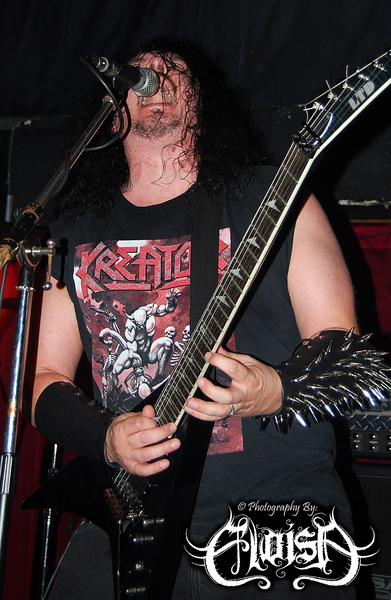 You played with Incantation for a while. What was it like touring with them? Any highlights that you’d like to share?
You played with Incantation for a while. What was it like touring with them? Any highlights that you’d like to share?
It was like most tours bands do where a lot of it is kind of bad but as soon as you get home you cannot wait go back out. Highlight show was in Santiago Chile with Cannibal Corpse and Death… I met many cool people during my time in Incantation but it all soured for me. I did meet my wife because I toured through Texas back then so that is something I do associate with the band as of course a great thing that came of it. Musically I am not meant to play for other people. I should do my own thing. More than one Alpha in a band is bad news… it could have been something, probably should have been but fuck it all…. was not meant to be and I lost interest in that band a long time ago
I’m curious to see which genre you regard Nokturnel as. Is it Technical Metal? Thrash? Death Metal? Black Metal? Or all of the above?
I now prefer to call it death metal but I really do not care anymore. People have been trying to label me since ’85 and they are usually wrong and it is not worth my time to argue. Nothing But the Hatred era material is harder to call death metal especially due to some of the humorous lyrical content but I saw that as a mistake and left that behind. People should realize that the extra track on Fury Unleashed, “A Collision of Dimensions” was a song in between Nothing But Hatred and Fury Unleashed and it showed the direction I was heading…. more death metal. People talk so much shit… too many solos, the vocals should be this way… it is not death or black…. blah blah blah…. I have watched the “scene” turn inside out several times over the years. Very few people have my respect anymore. Therefore… I do not care what anyone calls it if they happen to like it. That is good enough for me,
Nokturnel Eclipse has been supplying metal warriors with leather and spikes for over a decade. How did you come to crafting leather? Have you always been talented in this field?
I was seeing the need for a product and had a business that could easily carry it. My wife had made herself something that we felt we could take more into a typical metal armband. Osmose/Moonfog Black Metal was everywhere and people wanted Spikes. After some trials we introduced a few designs. Nokturnel Eclipse started by selling CDs which was destroyed by the digital shit we have today and now Nokturnel Eclipse focuses on Spiked Leather and Leather Masks.
Working with leather for yourself is one thing. Being able to sell it to customer after customer and build a reputation is another. We are now well known worldwide and have taken the whole process of creating what we offer farther than we ever thought. Years of experience make a big difference but making every single order perfect for every customer means a lot of hard work on our behalf. We are extremely busy which is great but it is delaying other new items we hope to add to Nokturnel Eclipse soon. We started in 1999 but things really took off for us in the past few years.
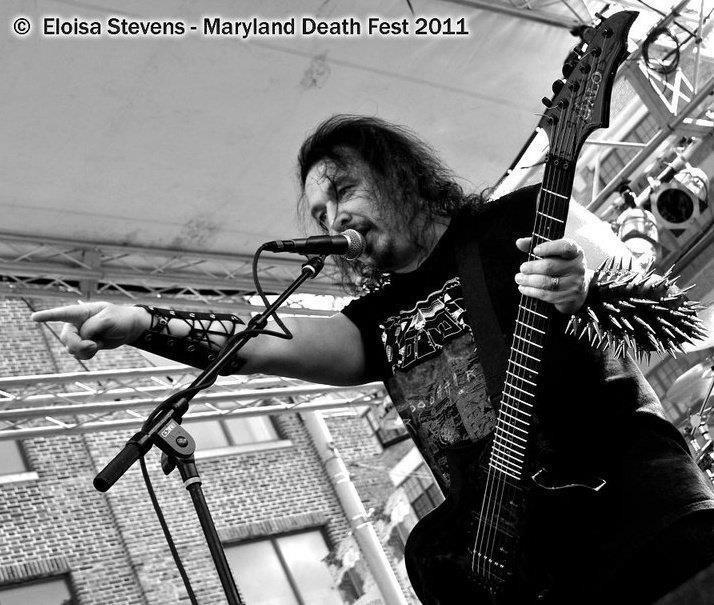 Please detail your contributions to Ripping Corpse. Are you still friends with Erik Rutan?
Please detail your contributions to Ripping Corpse. Are you still friends with Erik Rutan?
I became friends those guys early on in the Nokturnel demo days. We all got a long really well and were great friends, When they had shows booked out of state they did not want to miss and needed a bass player I was the go to guy. They knew I was capable of learning all their songs in a short period of time and I did just that including unrecorded new songs. They also stayed at my house during the recording of Dreaming With the Dead, I was there from the first note to final mix. I got to sing on all the backing vocals on the record and one other small part for half a second in “Glorious Depravity.”
I am friends with Rutan and consider all of them friends but it is Shaune Kelley I keep in touch with, I am a fan of almost any band any of my friends are in, of course that includes Hate Eternal but Shaune IS Ripping Corpse. The list of people I know in established bands is ridiculous. I do not speak to anyone on the phone often and do not go out of my way to keep up with any of them any more than any random person on the internet. I consider tons of people friends and we are happy to get together when they come through my area but I am a busy person and prefer the company of my family. My closest friends in bands get the invite to stay with us…. Rutan and Kelley would make that list.
You and King Fowley appear to be the best of pals. How many times have Nokturnel and Deceased played shows together? How long has your friendship been? There must be some crazy stories with you two in the early days of extreme metal.
Yes, we are. We agree on many things more so than disagree and know us older underground guys are a dying breed. I have known him and a lot of people since 1990 or earlier. Nokturnel and Deceased did quite a few shows together in the early 90s and I went to many shows down south where they were from on my own just to hang out. King and I are a lot alike but we are not by any means carbon copies of each other.
He is a unique personality and I would like to think people see me that way as well… One time I was with Deceased in Maryland we all piled into one hotel room. Long after everyone passed out I woke up to what I thought was a fucking gunshot. When I jumped out of my skin only one other person in the room woke up… I think it was King.. I looked through the curtain and saw some guy hauling ass through the parking lot, it was freezing during winter at the time. It turned out that some guy had bought a can of soda from a machine and smashed it through the window of the room next door. He was freezing out there and just had a freakout.
There’s some good babble [on this topic] in the book Glorious Times…One time in Cleveland we both played a show called Splatterfest. King misunderstood me and during their set invited the entire show to MY hotel. When I said see you there with everybody I meant Deceased… not half of Cleveland…. no fun telling carloads of people to go away that night, good times
You originally lived in New Jersey and relocated to Texas. I have noticed in previous statements that you have a disdain for your prior homeland. Why do you prefer Texas so much? Is it because Texas has the ability to secede if the US keeps twirling into nonsense?
Some people would consider leaving the area they grew up in a nightmare, for others it is a nightmare to stay. I much prefer the people of the South, not meaning metalheads…. they are the same no matter where you go, but people in general are easier to live with. NJ is a place I look back at knowing life for me got a whole lot better when I left. Some people refuse to leave and look for something better in life. I am not one of them. I moved to Florida around the time I joined Incantation which was no fun with the extra travel but even that was a massive upgrade for me.
Texas is fucking awesome. Great people, open minded and tolerant. Great weather, amazing food. When I met my wife she was living in Austin and it was a no-brainer for me to come to Texas instead of us staying in Florida. This is where we both want to stay. After living here and seeing almost everywhere you can think of…. I cannot see myself living anywhere else.
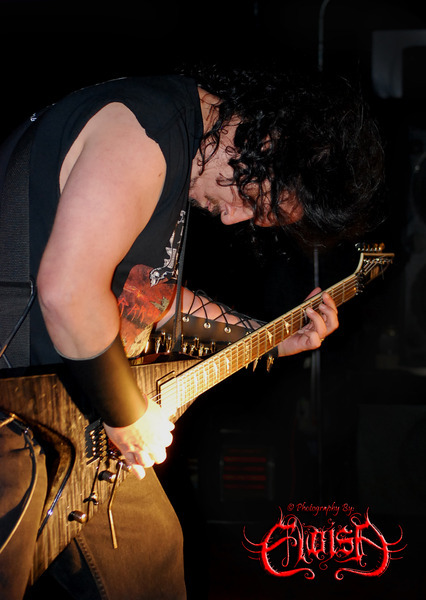 How long have you played guitar? You’re quite an amazing musician. What type of equipment, guitars, strings, etc do you use? What type of equipment would you recommend to new guitarists that are just starting out?
How long have you played guitar? You’re quite an amazing musician. What type of equipment, guitars, strings, etc do you use? What type of equipment would you recommend to new guitarists that are just starting out?
I began about 1980. I had experience playing piano when I was very young, which I blew off… I used to read complex sheet music and all this crap. I do not remember ANY of it. Matter of fact I only know the names of two guitar strings and one scale. All of my guitar [playing] is natural.
I took some basic lessons and was taught a few basic things before I was told I did not need any lessons and not to return. My teacher showed me “I Don’t Know” by Ozzy in the most retarded way imaginable. I showed him the right way; he was not mad. He made sure I knew how to tune the guitar and said I pick way too hard but I would be a great player some day… I was furious as I wanted to learn how to play lead. I figured it all out on my own. To these schooled modern shredders, they seem to pick me apart and explain everything I do in terms that mean nothing to me. “you don’t come all the way around on a this and don’t finish a that before you go into a….”…. I am thinking if I did that…. I would sound like you, and Nokturnel fans do NOT want that… so take your shred knowledge and tell someone who is easily impressed.
I am happy where I am in my own realm of demonic possession and appreciate others way more than they appreciate me. No sleep lost there. I am most known for using the Washburn EC29, but I currently play a Halo Inverted and having a Kahler Pro Series tremolo is mandatory. I only have one other V and am in the market for a new one now. I would appreciate it if you would link the Tremolo Torture video I did for Kahler. I talk a lot about why I need a Kahler tremolo.
I am a gain maniac. Crank a dual rectifier with active pickups and add more distortion and gain and noise and you are ready to create some noise, I think the two things a new player needs to help them gain confidence is proper reverb and a little delay effect. Best advice I can give anyone who wants to learn how to play… begin with Iron Maiden Piece of Mind, learn the riffs, learn the solos… you are now metal
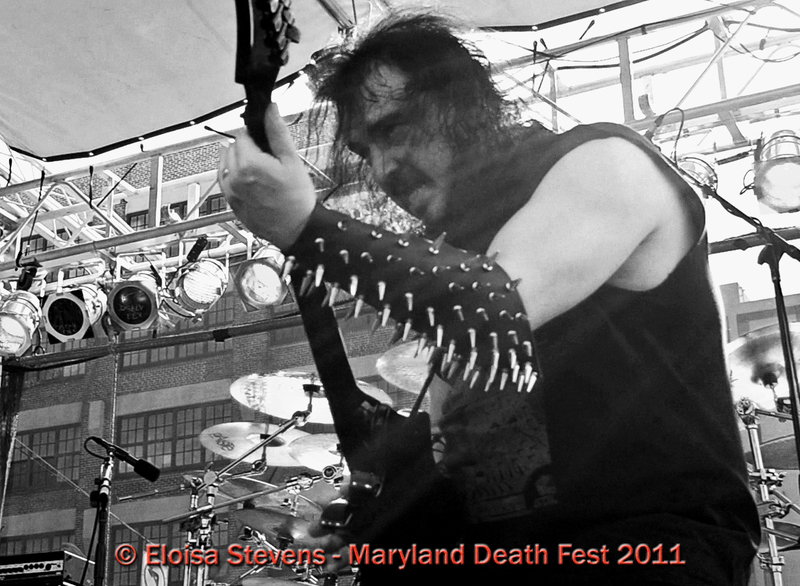 How well was the single “Ancestral Calling” received? What inspired you to write it? The riffs don’t seem to differentiate much, but the technical ability is amazing. How did you approach this song? What was your mindset? How will Nokturnel top this song in the future?
How well was the single “Ancestral Calling” received? What inspired you to write it? The riffs don’t seem to differentiate much, but the technical ability is amazing. How did you approach this song? What was your mindset? How will Nokturnel top this song in the future?
Overwhelmed with it really. It was incredible for me. I set out to do something I had not done in 20 years. A song based off only a few simple parts like Savage Death did in the 80s. I also wanted a song where the vocals and storyline dominate and that it did, Playing that song at Maryland Death Fest was the greatest moment for me in all of Nokturnel history. Seeing the crowd respond and even sing the words with me was just unbelievable. I was worried I kept it too simple, had feared Nokturnel fans would just not be into it. I was wrong, they fuckin’ flipped over it and I gained a ton of new fans. I feel I did top it.
The followup was “Shadows Alive” which is completely different. It is also based on real life paranormal experiences I was cautious about sharing with anyone. It is a very personal song for me and also much more furious than “Ancestral Calling.” Finding myself standing alone again after the last show I played and passing on other opportunities I chose to turn my back on everything and go back into the studio.
That song for me is a personal triumph. Not content with the few offers I got to play in 2013 and all the hassle to get the line up going I am now doing the same thing. Back in the studio alone, writing. “Shadows Alive” surpassed “Ancestral Calling.’ The new stuff I am working on now is way beyond that material, and believe me when I say I love all my music. This is why there are only so many Nokturnel songs as opposed to 10+ CDs worth. I am striving to make the best music…. not the most.. Every song counts.
Thank you for your time. If you have anything else that you’d like our readers to know, please share.
I think you did a great job with these questions. I managed to keep it short for a change, Thanks for that! I do intend to play shows again but I have a lot going on and much more work to do on new material. This band means more to me than anyone could understand, I have a lot more to offer and will fight to the death to make it happen.
Feel free to check out Tom’s businesses and music:
6 CommentsTags: Nokturnel
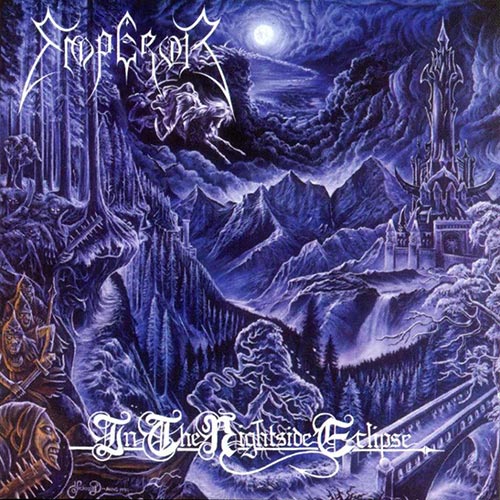
Inspired by Bosch, Dürer and Caspar David Friedrich, Kristian “Necrolord” Wåhlin has painted album covers for shiploads of underground bands since the early 90s (Therion and Dissection among others), but his most important and most striking contribution is probably the cover of Emperor’s In the Nightside Eclipse (1994).
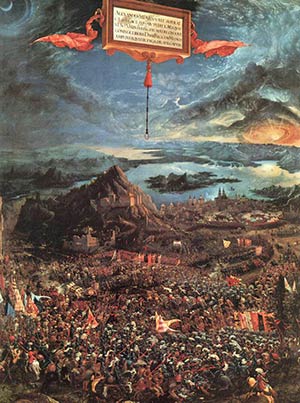 Some of its style and composition takes me back to Albrecht Altdorfer’s anachronistic oil painting The Battle of Alexander at Issus (1529), but true to the bleak genre of black metal the cover of ItNE is practically monochrome, which is rather typical of Wåhlin’s paintings at large (as seen in his paintings for Sacramentum’s Far Away From the Sun and Dark Funeral’s The Secrets of the Black Arts).
Some of its style and composition takes me back to Albrecht Altdorfer’s anachronistic oil painting The Battle of Alexander at Issus (1529), but true to the bleak genre of black metal the cover of ItNE is practically monochrome, which is rather typical of Wåhlin’s paintings at large (as seen in his paintings for Sacramentum’s Far Away From the Sun and Dark Funeral’s The Secrets of the Black Arts).
Wåhlin nevertheless manages to capture much of the grandeur sought by Emperor in those days. He allows us to delve in a detailed landscape of rugged forests, cold mountains and an army of monsters seemingly popping out of the ground in a setting of strange angles and charmingly inconsistent perspectives. High above, emanating from a crack in the clouds, Death sweeps his scythe across the sky, resonating the lofty keyboard phrases in the music of this album. The whole scene is awash in the light of the moon, gazing at us like a gate to eternity (try to outstare it during the finale of Inno a Satana …). The incorporation of Death seems to have been a way of providing a sense of iconic continuation, referring back to Emperor’s début EP which depicted a section of Gustave Doré’s engraving Death on a Pale Horse (Revelation). (The use of old engravings – especially those of Doré – seems a favourite means of visual expression in the universe of Emperor.)
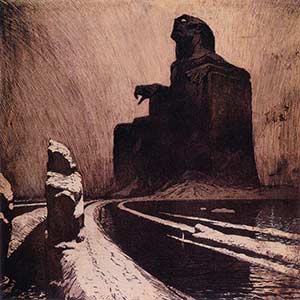 I always assumed that the otherworldly castle and the winding path leading to it were reminiscent of that of a certain bloodsucking count. This is probably no coincidence: have a look at the lyrics of the song Beyond the Great Vast Forest. Not only does it refer to Werner Herzog’s film Nosferatu (1979); parts of the story of the over-the-top film Bram Stoker’s Dracula (1992) – which was immensely popular around the time of ItNE’s inception – had also found its way into the lyrics, and the solitary structure of that film’s castle and its inspiration, František Kupka’s The Black Idol (1903), somewhat parallels the idea of the castle on display here.
I always assumed that the otherworldly castle and the winding path leading to it were reminiscent of that of a certain bloodsucking count. This is probably no coincidence: have a look at the lyrics of the song Beyond the Great Vast Forest. Not only does it refer to Werner Herzog’s film Nosferatu (1979); parts of the story of the over-the-top film Bram Stoker’s Dracula (1992) – which was immensely popular around the time of ItNE’s inception – had also found its way into the lyrics, and the solitary structure of that film’s castle and its inspiration, František Kupka’s The Black Idol (1903), somewhat parallels the idea of the castle on display here.
Ultimately, the cover of In the Nightside Eclipse confirms the nature of its music as slightly cheesy yet chillingly sincere, a satisfying visual representation of one of the best albums of the genre.
4 CommentsTags: album covers, emperor, in the nightside eclipse, necrolord